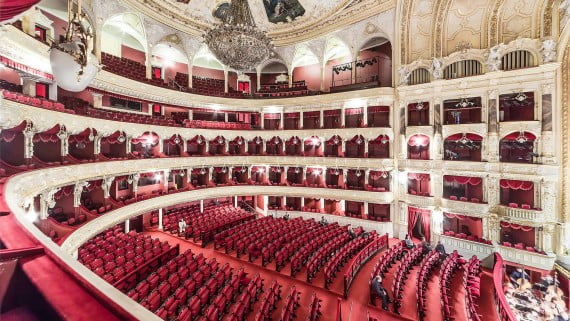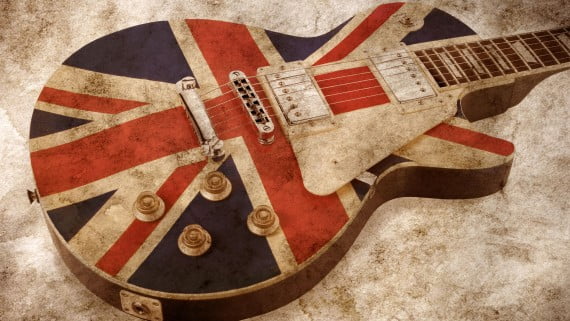From the 60th century to the era of unbridled pop during the XNUMXs, London it has been consolidating itself as one of the main musical capitals of the world. In this article we review the chronology of London music, without forgetting of course to mention the most important artists and bands of each moment.
Below you have an index with all the points that we are going to deal with in this article.
Article Index
- 1.
- 1.1.
- 1.2.
- 1.3.
- 1.4.
- 2.
- 2.1.
- 2.2.
- 3.
- 3.1.
- 3.2.
Classical tradition
As we said in the introduction, London It already had all the ballots to become a whole capital of music during the Tudor era, that is, during the XNUMXth and XNUMXth centuries. Later, the rise of English music continued its expansion thanks to the influence of Italian opera at the hands of Henry Purcell and Handel. In the following sections we present you a journey through the evolution of English classical music.
Medieval style
In the Tudor court you could hear renaissance music, typical in the historical-artistic panorama of this historical period.
It was not until England became a stable nation after the succession of the throne between Richard III and Henry VIII that there was a true flowering in the arts, especially in music. At this time, they were heard Carol's, ballads and the so-called court songs, currently recognized as the typical medieval songs.
It is said that Henry VIII was a true passionate about music and poetry, so it is not surprising that the lyrics of these songs were the most elaborate, usually playing themes that ranged from mourning to celebration, or dedicated to the Virgin Mary and Jesus Christ.
In short, throughout the entire Renaissance period, great works were composed in which the most used instruments were the viola, the recorder and the lute.
Such was Henry VIII's fondness for music and poetry, that it was he himself who composed the well-known song Greensleeves (literally, green leaves), which can be heard in the following video:
Elizabethan era
From the reign of Elizabeth I (1558-1603) until the seventeenth century, the use of music was clearly reduced, as it turned to Protestantism. Thus, the Masses and the Marian antiphons known as Eton Choirbook they were reduced to the use of simple compositions with little elaborate letters.
In addition, since the monasteries were dissolved, most of the choirs in England disappeared, so that the practice of musical activity was limited only to cathedrals and institutions that enjoyed royal protection.
Two were the musicians who stood out during the Elizabethan era. The first one was Thomas tallis, musician of the royal chapel pioneer in writing motets (short musical compositions of religious themes) with texts in English. In the following video you can listen to Tallis's composition titled Spem In Allium, one of the best known:
For his part, William Byrd became the first composer of the Elizabethan Golden Age thanks to his excellent work in the composition of secular and instrumental music. In short, they both adopted styles that were highly reminiscent of the flamenco style.
Popularization of opera
At the end of the XNUMXth century and from the s. XVII, at the same time that in Italy there was the decline of the composition called madrigal, there was an expansion of the genre par excellence of Italy and one of the italian customs of the present time: we talk about the opera. Thus, a great number of compositions arrived in England that were very well received, which mixed with the secular music of England and resulted in a mixture of styles.
Well into the seventeenth century, the leading role in the English music scene corresponds to the composer Henry Purcell (1659-1696), known for being the composer of the first English opera, entitled Dido and Aeneas, which saw the light in 1689. This work led him to receive the consideration of the best English composer of all time for being the creator of the characteristic English music of this period. Purcell developed instrumental, profane, scenic, and religious music. In this last style, works such as the Full anthem and See Anthem, among others.
In the XNUMXth century, the opera continued its expansion throughout the English territory thanks to the composer Georg Friedrich Handel (1685-1759), of German origin, although he became English national in 1726. Of Italian training, this author composed mainly sacred music and continued with the popularization of the opera that Purcell had begun in England.
Rise of the big concerts
During the period from the end of the XNUMXth century to the end of the XNUMXth century, English music did not stand out again. However, from the twentieth century it resumed its popularity from the hand of London composers such as Edward Elgar, Vaughan williams y Gustav Holst. Other notable names already in the postwar period are Michael Tippett and Benjamin Britten.
However, at this time large scale concerts and operas at the Royal Albert Hall, the English National Opera and the Royal Opera House became very popular. The foundation of the London Philharmonic Orchestra, based in the Royal Festival Hall in South Bank and today one of the most prestigious in the world. The English Chamber Orchestra and the BBC Symphony Orchestra are two other great institutions within the classical musical tradition of London.
Pop-rock revolution
After the Second World War, the United Kingdom and, especially, London lived through a post-war period in which important changes occurred at the socio-cultural level. Of course, this new vision was reflected in areas such as fashion and the arts, but without a doubt music is the best way to observe this evolution. Great music bands like The Beatles o The Rolling Stones were born in this period that we show you below.
Swinging London
It was not until the 1960s that London underwent a sea change in the field of the arts, especially in the music scene. This era is known by the English term Swinging London (swinging with the sense of expression in fashion), which is applied in a general way not only to the revolution in the field of music, but to the changes in fashion and culture that flourished from the 60's. This phenomenon was mainly oriented to the youth.
At this time great bands of the international music scene were formed such as The Beatles, The Rolliing Stones, The Who, The Small Faces and The Kinks, among many others.
The Beatles especially revolutionized popular London music, especially with the recording of their album Abbey Road and their famous photograph of the cover of it crossing the pedestrian crossing of this same street.
Meanwhile, the Rolling Stones They were also established among the greatest of international rock. His debut took place at the Ealing Club and his first concert was in 1962. In the following video you can see a performance of the Rolling Stones in Hyde Park, London, interpreting the hit Start me up:
The brit-pop
Already in the period that includes the 70s and 80s, musical bands of the stature of Pink Floyd, arrived from Cambridge, The Animals, Blind Faith, The Who and Eric Clapton, the latter from the outskirts, became known. Londoners.
Led Zeppelin, Queen, the Sex Pistols and The Police, among many others, are equally remarkable. A good handful of London-born soloists also made their mark on the international music scene: Cat Stevens, Marianne Faithfull and David Bowie, the latter a Brixton original.
Already in the time of the 90s, what is known as the movement emerged brit pop (Abbreviation of british pop, Meaning british pop) with groups the size of Oasis y Sweden. Both bands show a clear vindictive orientation towards the absence of pop guitar during the sixties and seventies.
Current musical panorama
Today there are many musical genres that have a place on the music scene coming from London. Of course, alternative rock, indie and pop keep their roots alive thanks to groups like Coldplay. But several styles of international origin have also arrived in the British capital, ranging from the drunk or hip hop even folk-rock, among others. Here we show you which are the main groups and soloists in London today.
Consecration of alternative rock and indie
At present, several are the alternative rock groups that have made the heritage of the groups mentioned above last in our days.
We talk, first of all, about the group Coldplay, led by Chris Martin, born in Exeter, Devon, England. Martin and his band define themselves as a group of melodic rockers. His debut took place in 1998 thanks to the album Parachutes, which was released in 2000. In short, Coldplay are today one of the most important London rock bands internationally.
The following video shows the official video clip of the song Yellow, belonging to their first album and turned into one of the most outstanding debut songs of the English band:
Also the band Kasabian deserves a special mention within the London music scene. With origin in the county of Leicestershire, in Leicester, England. Kasabian are an alternative rock band of British origin composed of Tom Meighan (vocalist), Sergio Pizzorno (guitarist and backup singer) and Chris Edwards (bassist). Since their debut in 2004, the band has on numerous occasions been compared to Oasis, among other alternative rock bands.
Since the beginning of the XNUMXst century, with the arrival of Asian immigrants to the British capital, London has had the opportunity to learn about the musical style of these countries thanks to artists such as Talvin Singh and Natin Sawhney, both famous for mixing the style dance with Hindu music.
Variety of styles
Today's London is a city that has become one of the world's leading centers for music creation.
Thanks to artists like Adele, hailing from Tottenham, London has been influenced by music drunk interspersed with British pop style.
Adele has established herself as one of the most popular British soloists internationally since her debut with the album. 21, which stayed for 10 weeks in a row at number 1 on the US charts with hits like Rolling in the Deep o someone like you, themes that you can listen to in the following video, which shows one of the artist's most remarkable performances at the Royal Albert Hall in London:
The style dubstep current, inheritance of the electronic music genre called grime, it is also very popular in England.
This style was born as an indigenous London musical genre that was born in the East End. Actually, this style is the result of merging the hip hop, drum 'n' bass and music garage British. Artists like Dizzee Rascal, Lethal Bizzle, Roll Deep, Lady Sovereign, GoldieLocks, and Kano.
As for musical bands, Muse, One Direction, Arctic Monkeys, etc. stand out. London folk-rock group Mumford & Sons He has also made a name for himself on the international music scene, like London rapper Tinie Tempah or Jessie Ware.
During the closing ceremony of the London Olympics 2012 a review was made of the last 50 years of British musical tradition. In it, great groups of the pop-rock revolution that we have already mentioned above such as The Beatles, Freddie Mercury and David Bowie were honored. There was also a special tribute to John Lennon, founding member of the Beatles. In the following video you can see this performance tribute to Lennon:
This article has been shared 26 times. We have spent many hours collecting this information. If you liked it, share it, please:








